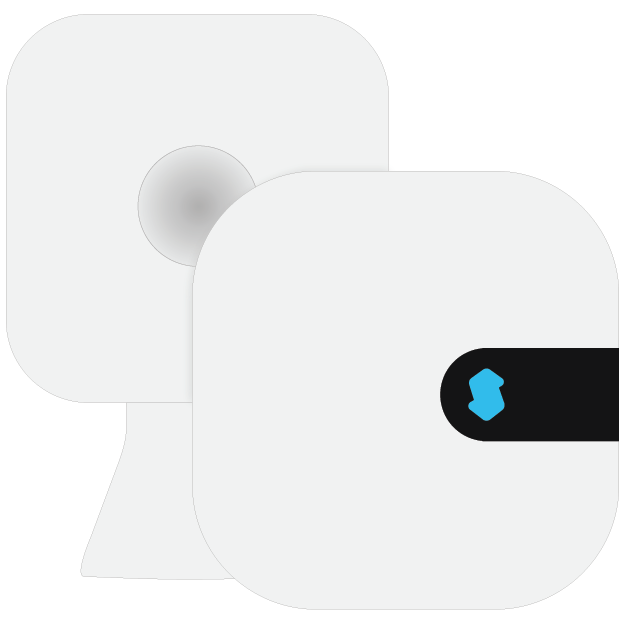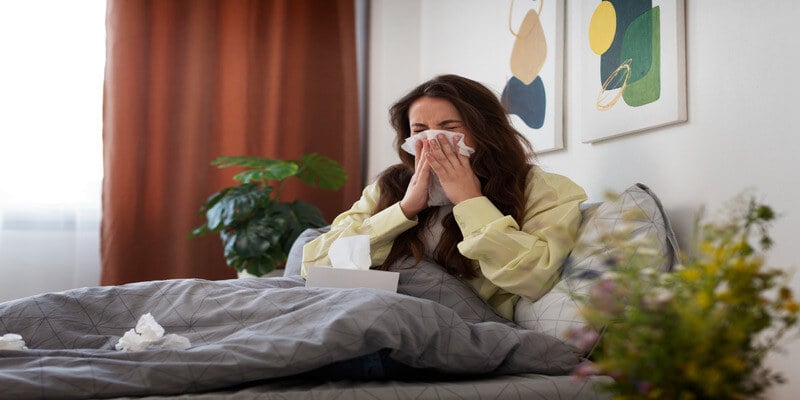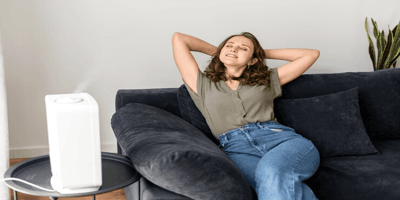What is Better For Allergies Humidifier or Air Purifier?
Waking up with a stuffy nose and itchy eyes again? If allergies are making your life miserable, you've probably wondered whether to grab an air purifier or humidifier from your local store. I've been there - standing in the aisle, scrolling through reviews on my phone, completely overwhelmed by options.
Here's the thing: both devices can help with allergies, but they work in completely different ways. Your sneezing fits might need one solution, while your neighbor's coughing might need another. Some allergy sufferers swear by their humidifier, while others can't imagine life without their air purifier for allergies.
In this guide, I'll break down exactly what each device actually does, who benefits most from each one, and when you might need both working together to breathe easier. No technical jargon - just practical advice from someone who's battled seasonal allergies for years.
What is a Humidifier?
Ever walk into someone's home in winter and immediately feel your skin and throat thanking you? That's what a good humidifier does - it adds moisture back into dry air.
A humidifier is essentially a water tank with a mechanism that transforms liquid water into vapor or mist. As this additional moisture spreads throughout your room, it becomes more humid. Although most homes feel comfortable between 30 and 50% humidity, indoor humidity can drop below 20% in naturally dry climates or during winter heating seasons, producing the ideal storm for some allergy symptoms.
There are several kinds, from warm mist models (better for killing bacteria) to cool mist versions (safer around children). Some sit on your nightstand while whole-house systems link straight to your HVAC. The idea is still that they are all meant to raise the moisture content in your air.
 How Does a Humidifier Help With Allergies
How Does a Humidifier Help With Allergies
When air gets too dry, our body's natural defenses weaken. That moisture barrier in your nasal passages? It's your first line of defense against allergens. A humidifier helps with allergies by:
- Keeping nasal passages moist, preventing cracking that allows allergens easier access
- Thinning mucus so your body can flush out irritants more effectively
- Soothing irritated throat tissues that trigger coughing fits
- Reducing the survival rate of certain viruses that thrive in dry conditions
For people with allergic asthma, adequate humidity can mean the difference between normal breathing and reaching for the rescue inhaler. Properly moistened airways respond better to medication and recover faster from irritation.
Advantages and Disadvantages of a Humidifier
Like any tool, humidifiers for allergies have their strengths and limitations worth considering:
Advantages:
- Immediate relief from dry throat and nasal passage irritation
- Reduced static electricity (which can actually attract dust to surfaces)
- Helps prevent bloody noses common during allergy season
- May improve sleep quality when congestion is an issue
- Often more affordable than quality air purifiers
Disadvantages:
- Requires regular cleaning to prevent mold growth (ironically becoming an allergy source)
- Can create too much humidity if not monitored, promoting dust mite growth
- Needs frequent water refills
- May leave mineral deposits on furniture if using tap water
- Won't actually remove allergens from your environment
I learned this lesson the hard way - my neglected humidifier once developed a concerning black film that was probably making my allergies worse, not better. Weekly cleaning is non-negotiable with these devices.
What is an Air Purifier?
 Think of an air purifier as your personal bouncer, checking every bit of air that tries to enter your lungs and kicking out the troublemakers.
Think of an air purifier as your personal bouncer, checking every bit of air that tries to enter your lungs and kicking out the troublemakers.
At its core, an air purifier pulls in room air, forces it through a series of filters that trap particles of different sizes, then releases the cleaned air back into your space. The best models capture particles as tiny as 0.3 microns - that's smaller than most allergens that trigger your symptoms. The heart of most purifiers is the HEPA filter (High-Efficiency Particulate Air), which must remove at least 99.97% of particles to earn the name.
Unlike humidifiers that add something to your air, purifiers subtract the stuff you don't want. They work continuously, cycling all the air in your room multiple times per hour to progressively reduce particle counts.
How Does an Air Purifier Help With Allergies?
This is where air purifiers help fight allergies most directly - by physically removing the triggers from your environment. They target:
- Pollen that drifts in through windows or on clothing
- Pet dander that floats around for hours after your dog leaves the room
- Dust mite waste (a major trigger for many allergy sufferers)
- Mold spores before they can find a damp spot to colonize
- Some volatile organic compounds that cause reactions in sensitive individuals
The reduction isn't theoretical - I've watched my dust allergies improve dramatically within days of running a quality purifier in my bedroom. For seasonal allergy sufferers, an air purifier for allergies creates a sanctuary where your immune system can finally take a break from constant alerts.
Advantages and Disadvantages of an Air Purifier
Advantages:
- Actively removes allergens rather than just making symptoms more tolerable
- Works continuously without requiring refills
- Many models include indicators showing current air quality
- Can help with multiple air quality issues beyond allergies (odors, smoke, etc.)
- Modern versions operate quietly enough for bedrooms
Disadvantages:
- Quality models cost more upfront than humidifiers
- Replacement filters create ongoing expenses
- Some produce trace amounts of ozone (avoid these models)
- Requires electricity to run constantly
- Only cleans the room it's in, not your entire home
The biggest mistake I see is people buying undersized purifiers. An air purifier for allergies needs adequate "air exchange rates" to make a difference - meaning it should be powerful enough for your specific room size.
What to Choose: an Air Purifier vs a Humidifier?
Let's cut to the chase - your specific allergy symptoms should guide this decision:
Go with an air purifier if:
- Your allergies flare up from pollen, pet dander, or dust
- You notice symptoms year-round regardless of humidity levels
- Your living space already has adequate humidity (30-50%)
- You live in a naturally humid climate
- Mold allergies are a significant concern
- Your symptoms include itchy eyes and sneezing fits
Choose a humidifier if:
- Your symptoms worsen during dry winter months
- Dry air triggers your asthma or allergic cough
- You wake up with an irritated throat and dried sinuses
- Nosebleeds accompany your allergy symptoms
- Your home consistently measures below 30% humidity
- Your heating system makes indoor air excessively dry
The reality? Many allergy sufferers benefit from both devices working together. An air purifier and humidifier combination tackles allergies from multiple angles - removing triggers while creating an environment where your body's natural defenses work optimally.
For example, during peak pollen season, I run my air purifier constantly while using a humidifier for allergies only at night to soothe irritated airways and improve sleep. This tag-team approach provides more complete relief than either device alone.
 Key Tips When Choosing Between a Humidifier and an Air Purifier
Key Tips When Choosing Between a Humidifier and an Air Purifier
After years of allergy battles, I've learned some crucial lessons about getting the most from these devices:
Know Your Readings
Invest in a humidity monitor (hygrometer) before buying either device. If your readings consistently show below 30%, a humidifier helps with allergies more immediately. Above 50%, focus on purification instead. This $10 tool prevents wasting money on the wrong solution.
Consider Your Specific Allergens
Dust mites thrive in humidity above 50%, so humidifiers for allergies can actually worsen these specific allergies if overused. Meanwhile, pollen and pet dander respond well to air purifiers for allergies regardless of humidity levels.
Room Size Matters
Both devices come with coverage ratings. Undersizing either one creates disappointment - an air purifier or humidifier rated for 300 square feet won't help much in your open-concept living area. Always size up if you're between recommendations.
Maintenance Determines Effectiveness
A neglected humidifier for allergies becomes an allergy trigger itself. Similarly, clogged filters in air purifiers stop capturing allergens effectively. Build cleaning routines into your calendar - I set monthly reminders for filter checks.
Consider Smart Features
The Sensibo Pure smart air purifier has revolutionized my approach to indoor air quality. Unlike basic models, it automatically adjusts to changing conditions by monitoring your air quality in real-time. I particularly appreciate how it ramps up filtration when cooking smoke or outdoor pollution spikes, then quiets down when air improves. The app notifications keep me informed about my home's air quality even when I'm away, and voice control through smart assistants means I never have to get out of bed to adjust it. Installation couldn't be simpler - just scan the QR code, connect to Wi-Fi, and it handles the rest.
For comprehensive allergy management, the right approach often involves situational use of both devices—running an air purifier consistently for allergies while using a humidifier strategically when conditions require it. This balanced approach creates the healthy indoor environment that allergy sufferers desperately need.



































.png?height=200&name=image5%20(1).png)
.jpg?height=200&name=close-up-side-view-man-blowing-nose-against-autumnal-leaves-against-plants%20(1).jpg)

.jpg?height=200&name=photo_2023-12-29_20-01-46%20(1).jpg)